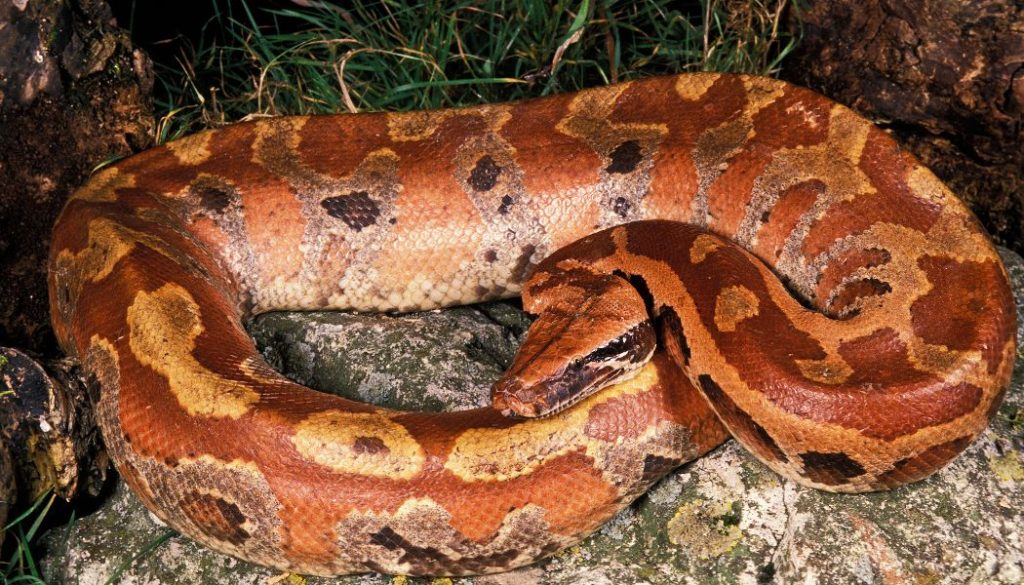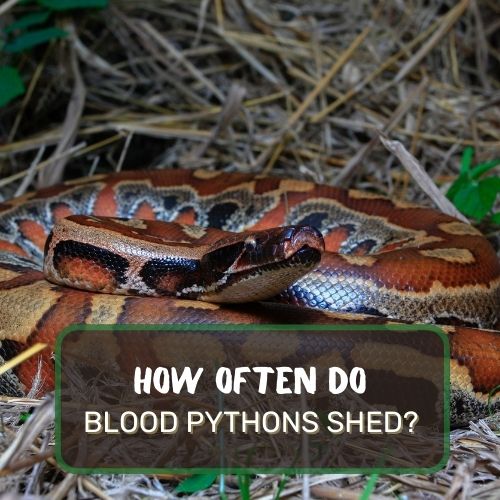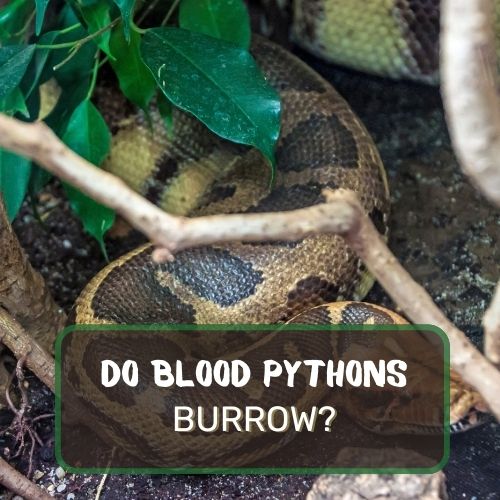Ready to dive into the captivating world of blood pythons as pets? Hold tight! This comprehensive guide will walk you through everything you need to know before committing to one of these exotic beauties.
Do blood pythons make good pets? Well, the answer depends on your experience level and what you’re looking for in a reptile companion. Blood pythons are stunningly beautiful and intriguing but can be a bit challenging for beginners.
They require specific habitat conditions, have unique feeding needs, and their temperament can vary. With proper care and understanding, they can be rewarding pets for those willing to invest the time and effort.
So, if you’re an experienced reptile owner or an enthusiastic beginner willing to do the homework, a blood python could be a great fit for you!
We’re covering everything from the level of experience you’ll need and their unique physical characteristics to their complex temperament.
We’ll also delve into the nitty-gritty of feeding and habitat requirements, break down the costs, and give you a pre-purchase checklist.
It’s a full 360-view to help you decide if a blood python is your next dream pet!

Table of Contents
- 1 First-Timers Beware: Experience Level Required
- 2 The Glam and the Not-So-Glam: Physical Characteristics
- 3 Temperament: Are Blood Pythons the Teddy Bears of the Snake World?
- 4 To Handle or Not To Handle: Blood Python Interactivity
- 5 What’s On the Menu? Feeding Time Basics
- 6 Habitat Requirements: Building the Perfect Python Palace
- 7 Budget Breakdown: The Economics of Owning a Blood Python
- 8 Before You Buy: Checklist of Considerations
- 9 Final Word
First-Timers Beware: Experience Level Required
So, you’re itching to become a blood python parent? Cool, but hold your horses! These aren’t your typical beginner-friendly garter snakes. Blood pythons have a rep for being a bit more complex to care for.
Sure, they’ve got this mysterious allure that’s hard to resist, but they also come with their set of challenges.
Let’s get into the nitty-gritty. Blood pythons are not the ideal “starter snake” for newcomers to the reptile-keeping game. They can be a bit sensitive to environmental changes, meaning you’ve gotta be spot-on with habitat control, like temperature and humidity.
And hey, these guys can be feisty! They’re not always up for cuddle sessions, so you gotta respect their space.
Do you have experience with other reptiles or, better yet, other snakes? That’s a big plus. It means you’re already familiar with the commitment and attention required for specialized care.
So if you’re a first-timer, it might be wise to start with a less demanding snake species and work your way up to the regal blood python.
The Glam and the Not-So-Glam: Physical Characteristics
Alright, let’s talk about what makes blood pythons the Beyoncés of the snake world, shall we? First off, their coloring is a showstopper.
With deep reds, striking blacks, and intricate patterns, these beauties will have you snapping pics for your Instagram like there’s no tomorrow.
But hey, what’s a superstar without a little bit of diva behavior? Blood pythons can grow up to a hefty 4 to 6 feet in length. That’s not huge compared to some other pythons, but they’re also stocky and muscular.
Imagine a short but ripped bodybuilder; that’s your blood python. They’re a substantial snake, and you’ll need to provide enough room for them to move around comfortably.
Now, let’s get real for a second. While they may have the glitz and glam, they can also be, well, let’s say a tad “high-maintenance.” These snakes prefer specific habitat conditions.
Too hot or too cold, and your python might go on a hunger strike. Too dry, and you could be looking at skin shedding issues. So their radiant scales and intricate patterns come with a user’s manual.
Blood pythons also have a particular “head shape” that makes them look slightly ticked off all the time, even when they’re not. It’s kinda like they’re giving you the side-eye, daring you to make the first move.
In a nutshell, if you’re up for the challenge, the blood python offers an awe-inspiring package of beauty and brawn. But be prepared; this is no low-maintenance pet. Like any superstar, they demand your attention, dedication, and, yes, unconditional love.
Temperament: Are Blood Pythons the Teddy Bears of the Snake World?
So, now you’re wondering, “Are these snakes just pretty faces, or do they have personalities to match?” Oh, they’ve got personalities alright, but teddy bears they are not!
Blood pythons have often been labeled as aggressive or moody, but here’s the inside scoop: They’re mostly misunderstood.
First things first, a lot of blood pythons in the pet trade nowadays are captive-bred, which usually makes for a calmer, more docile snake. That said, individual personalities vary.
Some might be chill and enjoy being handled, while others may hiss or even strike if they’re not in the mood. Think of them as the strong, silent types who don’t mince words—or hisses, in this case.
Now, you might’ve heard tales of blood pythons launching unprovoked attacks. Let’s clear the air: these instances are usually due to stress or improper handling.
So, if you know how to read their body language and give them their space when needed, you’re already ahead of the game.
To sum it up, while they might not be the teddy bears of the snake world, they’re not fire-breathing dragons either. Understanding and respecting their temperament is key. So, no, they’re not all cuddles and giggles, but with proper care and socialization, they can be fascinating and even affectionate companions.
To Handle or Not To Handle: Blood Python Interactivity
The million-dollar question—can you actually handle a blood python without it turning into a wrestling match? The answer is a qualified yes.
Once you’ve gained their trust, many blood pythons can be handled without too much drama. But there’s a “getting to know you” period that you have to respect.
Blood pythons, especially younger ones, may be a bit skittish at first. Quick movements or reaching directly from above (making you look like a predator) can freak them out. It’s all about gradual desensitization.
Start by letting them explore your hand in their enclosure before picking them up. Make the initial sessions short and sweet, gradually increasing the time as they become more comfortable.
But here’s a pro tip: avoid handling them right after they eat or while they’re shedding. These are sensitive times when even the most placid snake can become irritable.
So, to handle or not to handle? It’s really up to you and your snake. Each blood python has its own comfort zone when it comes to human interaction. With patience, careful observation, and a gentle touch, you can build a rewarding relationship with these captivating creatures.
What’s On the Menu? Feeding Time Basics
Alright, let’s get down to one of the most critical aspects of blood python care—feeding. Trust me, you don’t want a hangry blood python on your hands! These guys are primarily rodent connoisseurs.
We’re talking rats and mice, either frozen-thawed or fresh, depending on your comfort level and what’s best for the snake.
Now, how often should you feed them? For younger blood pythons, a small meal every 5-7 days is generally a good rule of thumb. As they grow, you can space it out to every 7-10 days and offer larger prey items.
But hey, don’t go overboard. Overfeeding can lead to obesity, and nobody wants a chunky snake that’s prone to health issues.
Feeding time can be quite an event, almost like dinner theater but with a reptilian star! Some people use feeding tongs to offer the prey, while others place the food item in the enclosure for the snake to discover.
The key is to observe your snake and figure out what feeding style suits them best. Remember, every snake is an individual, and what works for one might not work for another.
Habitat Requirements: Building the Perfect Python Palace
So you’re ready to go all out on MTV Cribs—Python Edition, huh? Creating the ideal environment for your blood python is like laying the foundation of a house. Get it right, and you’ll have a happy, healthy snake; get it wrong, and you’ll both be stressed out.
Firstly, size matters. A young blood python might be okay in a 20-gallon enclosure, but as they grow, you’ll want to upgrade to at least a 40-gallon tank or its equivalent. Make sure it’s secure; these guys are escape artists!
Temperature and humidity are your next big tickets. Blood pythons are tropical creatures, so aim for a temperature gradient of 75-82°F and a humidity level around 60-70%. Trust me, get these wrong, and you’re asking for health problems.
As for decor, think “jungle gym.” Provide hides for security and branches or platforms for climbing. Substrate should be absorbent and easy to clean—think cypress mulch or coconut fiber. And don’t forget a water dish large enough for them to soak in.
Lighting is a bit of a controversial topic in the snake world, but a low-level UVB light can be beneficial. Just make sure you also provide areas of shade for your python to escape the light when they want to.
Budget Breakdown: The Economics of Owning a Blood Python
So, you’re sold on the blood python’s looks and intrigued by its personality. But what’s this going to cost you? Well, let’s break it down. First off, the snake itself can cost anywhere from $100 to a whopping $500, depending on the specific morph or coloration. But wait, there’s more!
The initial setup, including a suitable enclosure, can run you another $100 to $300. Don’t forget heating and lighting elements, which can add another $50 to $100. Oh, and substrate, hides, and climbing branches? Add another $50.
Now, let’s talk ongoing expenses. Food will cost you around $10 to $20 per month. Add some bucks for occasional vet check-ups and any necessary supplements or medications. In the long run, you’re looking at a few hundred bucks a year to keep your blood python living the high life.
Before You Buy: Checklist of Considerations
Okay, we’ve covered a lot, but before you dash off to the nearest reptile expo, here’s a quick checklist of things to think about:
- Experience Level: Are you a seasoned reptile keeper or a newbie?
- Space: Do you have enough room for a proper enclosure?
- Time: Are you committed to the regular care and maintenance?
- Budget: Can you afford both the startup and ongoing costs?
- Temperament: Are you comfortable with a pet that has a “strong personality”?
- Local Laws: Are there any restrictions on keeping pythons in your area?
Tick off these boxes, and you’re well on your way to becoming a responsible and loving blood python parent. This isn’t a decision to make on a whim; it’s a long-term commitment that demands thoughtfulness and preparation. So go ahead, ponder, prepare, and then dive into the fascinating world of blood pythons!
Final Word
You’ve journeyed through the ins and outs of blood python ownership, from understanding their complex temperament to meeting their habitat and dietary needs.
They’re not the easiest pets to care for, but with dedication and a willingness to learn, you can create a rewarding relationship with these captivating creatures.
Remember, the more informed and prepared you are, the better the experience will be for both you and your scaly friend.
So, if you’re up for the challenge and excited by the uniqueness that blood pythons bring to the table, go ahead and take the plunge. Your future serpent buddy awaits!




0 Comments